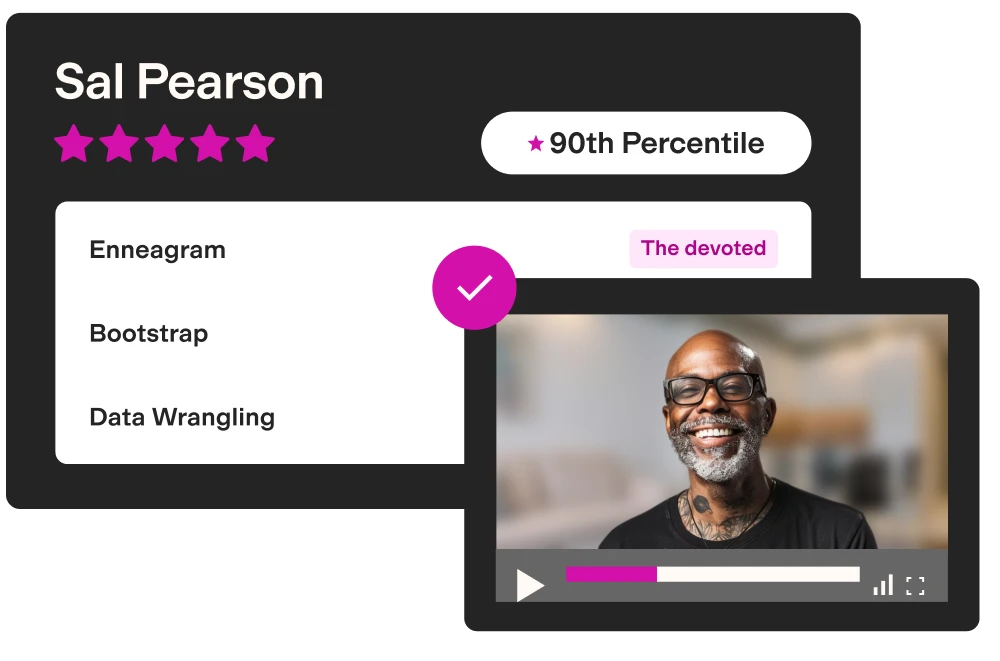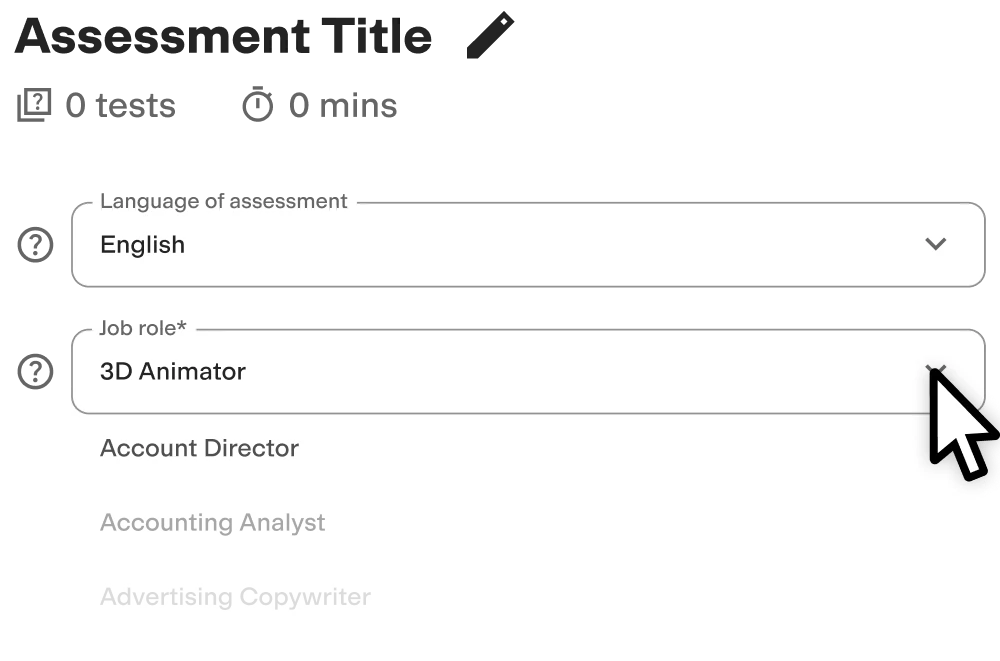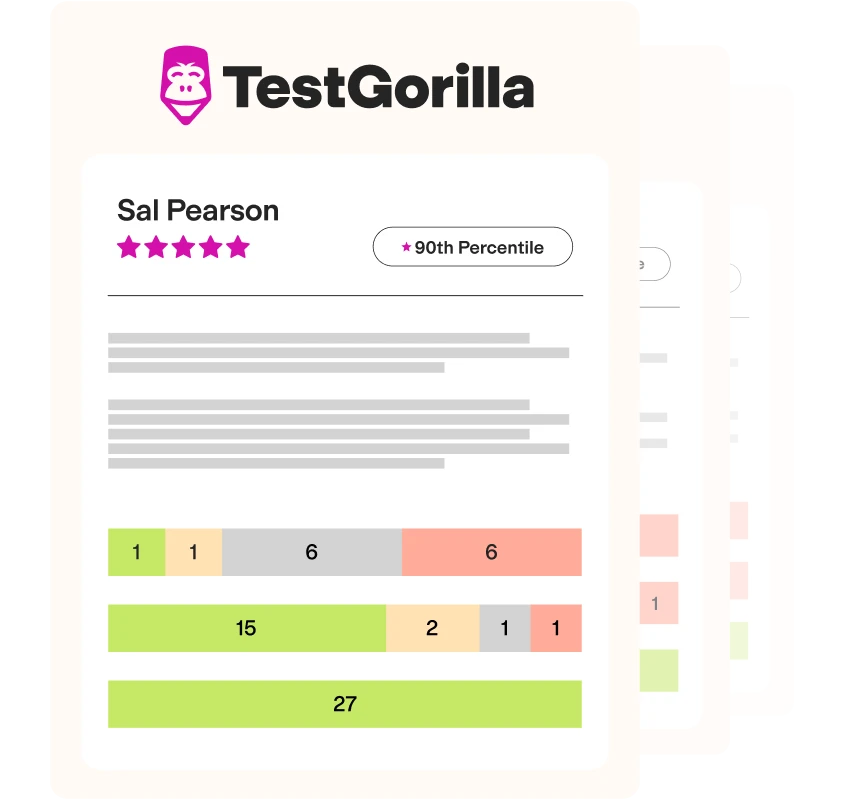Spatial Reasoning test
Summary of the Spatial Reasoning test
This Spatial Reasoning test evaluates a candidate’s ability to analyze 2-dimensional and 3-dimensional objects and space. This test is relevant for STEM-related jobs (Science, Technology, Engineering, and Math) and analytical skills testing.
Covered skills
Mental rotation
Spatial working memory
Mental folding
Spatial visualization
Use the Spatial Reasoning test to hire
Mechanical engineers, chemical engineers, researchers, designers, architects, and other STEM-related jobs in science, technology, engineering, and mathematics.
About the Spatial Reasoning test
This Spatial Reasoning test covers understanding, reasoning, and remembering the spatial relationships among objects or space. These skills play an important role in science, technology, engineering, and math (STEM) and show candidates' analytical thinking skills in terms of objects and space.
Spatial reasoning skills are found to be valuable in STEM-related careers. For example, an astronomer must visually imagine the structures of a solar system, and the path of the bodies within it. An engineer must visually imagine the motions of the parts of a machine or building that they are assigned to work with. Chemists must be able to understand abstract models representing the spatial dynamics of molecules.
There is also evidence that spatial reasoning is involved in many aspects of processing numbers and calculating in math. Even in physics, spatial visualization ability is crucial for solving kinematic problems. There are four common types of spatial reasoning abilities which include spatial visualization, mental folding, and mental rotation. These abilities have unique properties and are important to various types of tasks encountered in professional life.
For example, spatial visualization is characterized as complicated multi-step manipulations of spatially presented information. Mental rotation is the ability to manipulate and rotate 2D or 3D objects in space quickly and accurately. These three abilities are mediated and supported by a fourth spatial cognitive factor known as spatial working memory.
Spatial working memory is the ability to temporarily store a certain amount of visual-spatial memories under attentional control in order to complete a task. This cognitive ability mediates individual differences in the capacity for higher-level spatial abilities such as mental rotation. The test covers these common types of spatial reasoning abilities to help you identify candidates with strong skills. This is a great test to include to check analytical skills.
The test is made by a subject-matter expert
TestGorilla’s tests are created by subject matter experts. We assess potential subject-matter experts based on their knowledge, ability, and reputation.Before being published, each test is peer-reviewed by another expert, then calibrated using hundreds of test takers with relevant experience in the subject.
Our feedback mechanisms and unique algorithms allow our subject-matter experts to constantly improve their tests.
Anirban C.
The global IT industry has benefited from Anirban’s talents for over two decades. With a flawless reputation that precedes him, Anirban has earned a status as a sought-after agile project manager and consultant. He’s worked internationally as a Senior Project Manager with companies such as Ericsson, IBM, and T-Mobile.
Anirban’s love for learning helps him keep his skills sharp. He holds an MBA and a degree in engineering, is a certified Scrum Master, and has certifications in Prince2 and ITIL.
Use TestGorilla to hire the best faster, easier and bias-free
Our screening tests identify the best candidates and make your hiring decisions faster, easier, and bias-free.
Create high-quality assessments, fast
Building assessments is a breeze with TestGorilla. Get started with these simple steps.
What is spatial reasoning and why is it important?
Spatial reasoning is the awareness of objects, the area or space they occupy, and their relative position to each other. In summary, it is the understanding of how objects can move and interact in a three-dimensional world.
Although it may sound like a strange concept, spatial reasoning contributes to our awareness of things in our environment. As a skill developed from childhood, it contributes to how individuals interact with everything around them. This includes:
• Reading and writing: Spatial reasoning helps individuals understand sentence structure and grammar.
• Mathematics: With concepts like geometry and numerical arrangement, it’s used to solve problems and use mathematical reasoning.
• Location: This skill helps people understand where things are located in relation to other things.
• Movement: Spatial reasoning enables us to comprehend how objects and people move through and navigate environments.
As a skill, spatial reasoning is a part of everyone’s life, but more advanced use of the skill is common in jobs in STEM (science, technology, engineering, and mathematics), as well as some creative roles like graphic design and photography. Let’s look at its role in the workplace.
Spatial reasoning in the workplace
In many jobs, spatial reasoning is crucial for problem-solving, analytical thinking, and information processing. People who excel at this skill can spot patterns and relationships between objects, which in turn help them perform their tasks. Some examples are:
• Architecture: An architect should understand how parts of a structure they have designed will interact when they are put together.
• Mechanical engineering: An engineer needs to visualize how machine parts will work together before the parts are made.
• Surgery: A surgeon needs to understand how medical tools will affect each other, as well as their patients’ tissue, before they operate.
If this skill is crucial to any role in your organization, how do you make sure you recruit the best candidate for the job? A spatial reasoning test may be the solution. Let’s explain.
Recruit with a Spatial Reasoning test
Evaluating candidates on their skills is an effective way to predict their job success. When you’re recruiting for a position that requires specific competencies, a skill-specific assessment like a spatial-reasoning test can help you gain insight into your applicants’ abilities.
Our Spatial Reasoning test can help you evaluate a candidate’s ability to interpret two- and three-dimensional spatial objects. Testing will identify job applicants who understand, infer, and remember connections between objects or spaces.
What’s more, pre-employment testing gives you comparable data on all the candidates. This means that you can compare applicants based on their skills and see who is the best fit without once looking at their CVs.
TestGorilla’s test questions give candidates realistic scenarios that mirror the work experience of the position they are applying for. This means the questions reflect practical experience.
In addition, TestGorilla’s platform automatically calculates candidates’ test scores. This helps you to quickly evaluate and compare applicants' skills and strengths. As a result, your HR team can make hiring decisions based on facts and data, rather than any prejudice.
What does a spatial reasoning test evaluate?
TestGorilla’s Spatial Reasoning test evaluates candidates in the areas of spatial ability: spatial visualization, spatial working memory, mental folding, and mental rotation. People with strong spatial thinking skills can identify links and patterns between objects and this test assesses this ability by assessing whether candidates can:
• Understand how various processes or practices interact with one another
• Participate in various visual simulations at once
• Manipulate, comprehend, and employ visible entities
This Spatial Reasoning test covers these common skills to help you identify which candidates will excel in the workplace. In addition, the test can help you evaluate applicants on their analytical skills.
The benefits of TestGorilla’s pre-employment tests
• Created by subject-matter experts: Like our Spatial Reasoning test, all TestGorilla tests are created by experts in the field and are peer-reviewed to ensure their accuracy and effectiveness.
• A variety of tests: Our tests cover a wide variety of soft and hard skills, and can be used for jobs in a variety of industries.
• Data-driven insights: TestGorilla’s assessment results enable you to see how your applicants performed, as well as giving you insight into how they compare with each other.
• Personalized assessments: Our platform lets you create an assessment tailored to your role by choosing from a variety of tests. It also gives you the opportunity to add custom questions.
• Bias-free recruitment: To create diverse teams that help your business grow, TestGorilla’s pre-employment assessments help eliminate unconscious bias from the recruitment process.
• No CVs required: Assessing candidates for skill and culture fit is a more effective way of finding the right hire. With TestGorilla, you can recruit the best without sifting through dozens of CVs.
• Streamlined recruitment: By evaluating candidates with a pre-employment test and removing CVs from the recruitment process, you can simplify and speed up your hiring process.
In summary
We’ve established that pre-employment testing is a simple yet effective way to gain insight into your candidates’ skills and identify the applicant with the right skills for the job. But what makes testing with TestGorilla’s assessments valuable to your recruitment process is that you can test candidates on a variety of soft and hard skills.
TestGorilla’s pre-employment assessments can include role-specific tests like the Spatial Reasoning test andtests for soft skills. This means that you can find the candidate who will be the best fit in term of not only technical skills, but also personality and culture add.
Ready to recruit the best? Use our Spatial Reasoning test to streamline your recruitment process and help you find candidates who will excel in the role.
FAQs
View a sample report
The Spatial Reasoning test will be included in a PDF report along with the other tests from your assessment. You can easily download and share this report with colleagues and candidates.







